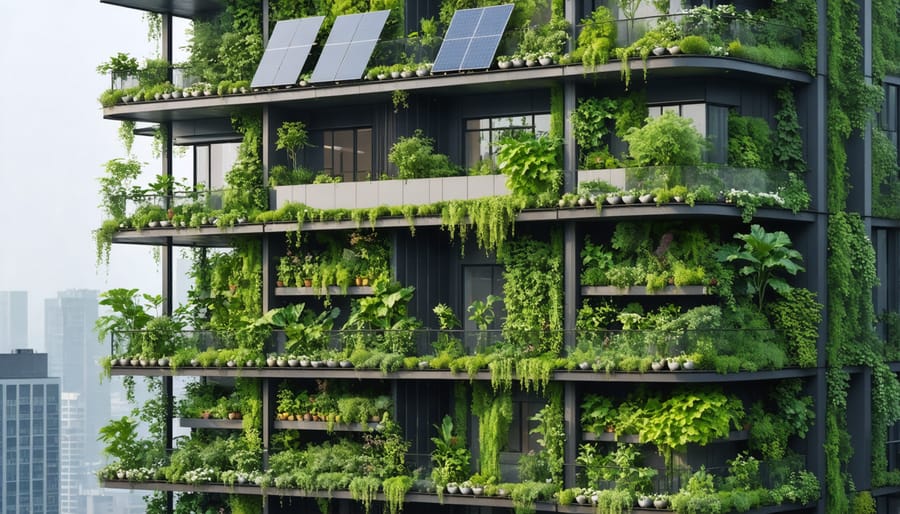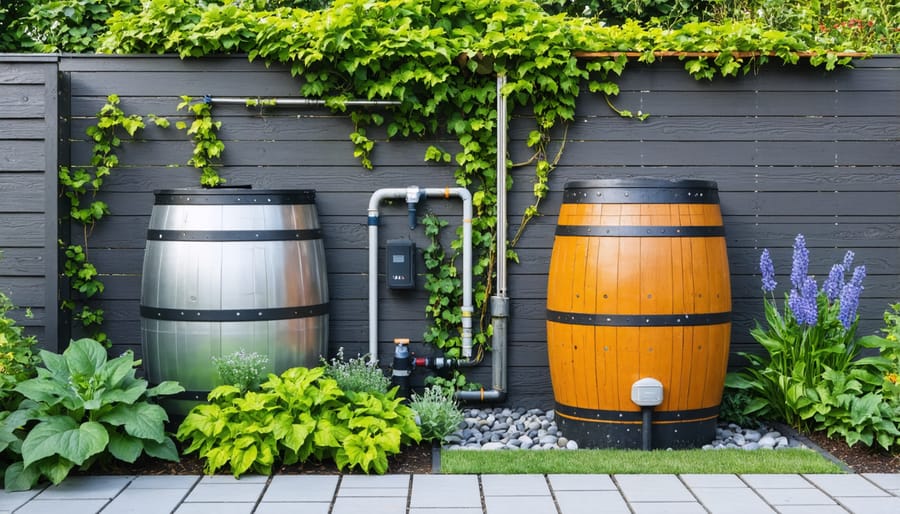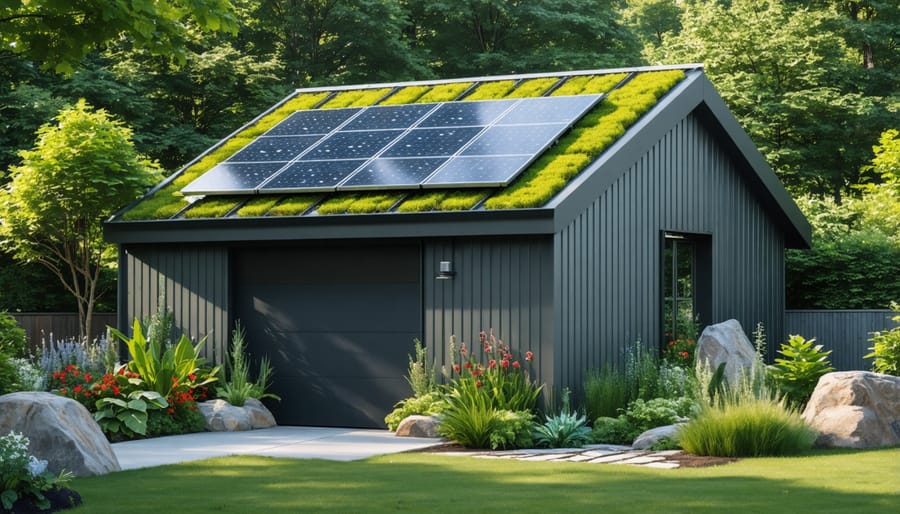Smart Urban Living: Beautiful Outdoor Spaces That Save Money and Energy

Transform your urban living space into a sustainable sanctuary by embracing smart, eco-conscious solutions that work in limited city environments. The future of sustainable cities isn’t just about massive infrastructure projects—it starts with individual choices in our homes, balconies, and small outdoor spaces. Today’s urban dwellers are pioneering a revolution in sustainable living, proving that you don’t need acres of land to make a significant environmental impact.
Modern sustainable urban living combines innovative technology with time-tested practices: vertical gardens that maximize limited space while improving air quality, smart home systems that optimize energy usage, and community-based initiatives that transform neighborhoods into green zones. These solutions not only reduce our carbon footprint but also create more livable, enjoyable urban spaces.
Whether you’re in a compact apartment or a city townhouse, sustainable urban living is about making intentional choices that benefit both your immediate environment and the broader ecosystem. From installing solar panels on rooftops to creating balcony composting systems, every small action contributes to a larger movement toward urban sustainability. The key lies in adapting sustainable practices to fit your specific urban context while building connections with like-minded community members who share your vision for a greener future.
Creating Your Sustainable Outdoor Living Space
Space-Efficient Storage Solutions
Creating space-efficient storage solutions in urban environments requires innovative thinking and eco-conscious design. Green-roofed storage sheds have emerged as a brilliant solution, offering both practical storage and environmental benefits. These structures feature living roofs covered with drought-resistant plants, which help manage stormwater runoff, provide insulation, and create habitats for local wildlife.
Multi-purpose structures are another game-changer for urban homeowners. Consider a garden shed that doubles as a vertical growing space, with built-in wall planters and adjustable shelving systems. These clever designs maximize every square inch while contributing to your home’s sustainability goals.
For those with limited outdoor space, modular storage units offer flexibility and adaptability. These can be configured to fit awkward spaces and expanded as needed. Look for units made from sustainable materials like bamboo or recycled plastic, which offer durability while minimizing environmental impact.
Smart organization within these spaces is crucial. Use clear storage bins made from recycled materials, install solar-powered lighting, and incorporate rainwater collection systems. Many urban gardeners have found success with wall-mounted tool organizers and fold-down workbenches that can be tucked away when not in use.
Remember to consider seasonal needs when planning your storage solution. A well-designed space should accommodate both summer gardening equipment and winter storage requirements while maintaining its eco-friendly functionality throughout the year.
Water Conservation Features
Water conservation is a cornerstone of urban sustainable living, and implementing smart water management systems can significantly reduce your environmental footprint while creating a beautiful outdoor space. One of the most effective ways to conserve water is through rainwater harvesting systems, which collect and store rainwater for various household uses.
Installing rain barrels or larger cisterns beneath your gutters can provide a sustainable water source for garden irrigation, car washing, and other outdoor needs. These systems can be seamlessly integrated with your existing drainage setup and can even complement your sustainable landscaping designs.
Drought-resistant landscaping, also known as xeriscaping, is another powerful water-saving strategy. Choose native plants that thrive in your local climate with minimal watering needs. Consider replacing traditional grass lawns with attractive alternatives like sedge, clover, or ornamental grasses that require less maintenance and water.
Smart irrigation systems with moisture sensors and programmable timers can optimize water usage by delivering precise amounts only when needed. Mulching around plants helps retain soil moisture and reduces evaporation, while permeable pathways and rain gardens can help manage stormwater runoff effectively.
These water conservation features not only help protect our precious water resources but can also lead to significant savings on your water bills while creating a resilient and beautiful outdoor environment.

Energy-Smart Outdoor Structures
Solar-Powered Storage Units
Solar-powered storage units represent a brilliant fusion of functionality and sustainability in urban living. By incorporating solar panels into your shed’s design, you can transform a simple storage space into an energy-generating powerhouse that serves multiple purposes while reducing your carbon footprint.
Modern solar-equipped sheds typically feature roof-mounted panels that can generate enough electricity to power internal lighting, security systems, and even small appliances. Many homeowners use this sustainable energy source to charge electric garden tools, run ventilation fans, or power a small workspace within the unit.
“Since installing our solar-powered shed last spring, we’ve not only solved our storage needs but also reduced our monthly energy bills,” shares Sarah Chen, an urban homeowner in Portland. “The motion-sensor lights and ventilation system run completely off-grid.”
Key benefits of solar-powered storage units include:
– Zero ongoing electricity costs
– Increased property value
– Reduced carbon emissions
– Enhanced functionality of your storage space
– Independent power source during outages
When planning your solar storage solution, consider starting with a basic setup of 2-4 panels (200-400 watts total) for essential lighting and security features. You can always expand the system later as your needs grow. The initial investment typically pays for itself within 3-5 years through energy savings.
Installation is straightforward for most DIY enthusiasts, though professional help is recommended for electrical connections. Remember to position your shed where it receives maximum sunlight exposure, typically facing south in the Northern Hemisphere, and keep nearby trees trimmed to prevent shade coverage.

Natural Lighting Solutions
Natural light isn’t just about brightening up your space; it’s a sustainable solution that can significantly reduce your energy consumption and create a more pleasant environment. Maximizing natural light in your outdoor structures involves strategic planning and smart design choices that work harmoniously with the sun’s path.
Start by considering the orientation of your outdoor structures. South-facing windows capture the most sunlight throughout the day, while east and west-facing openings provide balanced morning and afternoon light. Installing skylights or solar tubes can bring in overhead illumination, perfect for spaces where wall windows aren’t practical.
Clear polycarbonate panels are an excellent alternative to traditional roofing materials, allowing natural light to filter through while maintaining structural integrity. These panels are durable, weather-resistant, and can replace sections of your roof or walls to create well-lit areas without compromising security.
Consider incorporating reflective surfaces and light-colored materials in your design. White or pale-colored walls bounce light deeper into the space, while strategically placed mirrors can redirect sunlight to darker corners. Light shelves – horizontal surfaces mounted above eye level – can bounce daylight deeper into your structure while providing shade during summer months.
For seasonal adjustment, retractable awnings or adjustable shutters offer flexibility in controlling light levels. These features help prevent overheating in summer while maximizing warm sunlight during winter months. Remember to keep windows and light-permitting surfaces clean and unobstructed to maintain optimal natural lighting throughout the year.
By implementing these natural lighting solutions, you’ll create more inviting outdoor spaces while reducing your environmental impact and energy costs.
Sustainable Materials and Maintenance

Eco-Friendly Building Materials
When it comes to creating sustainable outdoor structures, choosing the right eco-friendly building materials can make a significant impact on both the environment and your wallet. Today’s market offers numerous sustainable options that combine durability with environmental consciousness.
Reclaimed wood has become increasingly popular for outdoor structures, offering unique character while preventing deforestation. Look for certified salvaged timber from old buildings, barns, or industrial sites. Not only does this option reduce waste, but it also adds a distinctive rustic charm to your outdoor space.
Bamboo is another excellent sustainable choice, growing up to 20 times faster than traditional hardwoods. Its natural resistance to pests and moisture makes it ideal for outdoor applications, while its strength rivals that of steel in some circumstances.
Recycled metal and plastic composites have revolutionized outdoor construction. These materials are weather-resistant, require minimal maintenance, and help reduce landfill waste. Many manufacturers now offer decking and siding made from recycled plastic bottles and industrial waste, providing a durable alternative to traditional materials.
For roofing, consider recycled rubber tiles or living green roofs. Rubber tiles, often made from repurposed vehicle tires, offer excellent durability and weather protection. Green roofs, while requiring more initial planning, provide natural insulation and create valuable habitat for local wildlife.
Natural insulation materials like sheep’s wool, recycled denim, or cellulose (made from recycled paper) offer excellent temperature regulation without harmful chemicals. These materials are particularly effective in climate-controlled outdoor structures and can significantly reduce energy consumption.
When selecting finishes, opt for low-VOC (Volatile Organic Compounds) paints and sealants. These products minimize harmful emissions while providing excellent protection against the elements. Many manufacturers now offer plant-based finishes that are both effective and environmentally responsible.
Remember to source materials locally when possible to reduce transportation emissions and support your community’s economy. Many areas have salvage yards and eco-friendly building supply stores that specialize in sustainable materials.
Green Maintenance Practices
Maintaining your outdoor structures sustainably isn’t just good for the environment – it’s also budget-friendly and helps extend the life of your investments. Start by choosing eco-friendly cleaning solutions like vinegar and water mixtures or biodegradable soaps instead of harsh chemicals. These natural alternatives effectively clean surfaces while protecting your garden soil and local waterways.
Regular inspection is key to sustainable maintenance. Check for water damage, loose fixtures, or pest problems every season. Catching issues early prevents the need for major repairs and reduces material waste. When repairs are needed, opt for reclaimed or recycled materials whenever possible.
Consider applying natural wood preservatives like linseed oil or beeswax to protect wooden structures. These alternatives to chemical-based sealants are better for the environment and safe for nearby plants. For metal components, use rust-preventing solutions made from natural ingredients to extend their lifespan.
Water management plays a crucial role in green maintenance. Install rain barrels to collect water from structure roofs, which you can use for cleaning and watering plants. Ensure proper drainage around your outdoor structures to prevent water damage and reduce the need for repairs.
Create a maintenance schedule that aligns with natural cycles. Spring and fall are ideal times for thorough inspections and repairs. During summer, focus on ventilation and preventing heat damage. In winter, protect structures from snow and ice using eco-friendly methods like brush removal instead of chemical de-icers.
For pest control, embrace natural solutions like companion planting or installing bird houses. These methods create a balanced ecosystem that naturally deters unwanted visitors while supporting local wildlife. Consider adding green roofs to smaller structures – they provide insulation, extend roof life, and create habitats for beneficial insects.
Remember to properly dispose of any maintenance waste. Compost organic matter, recycle appropriate materials, and responsibly dispose of items that can’t be reused. This comprehensive approach to green maintenance ensures your outdoor structures remain functional while minimizing environmental impact.
As we’ve explored throughout this article, urban sustainable living isn’t just a trend – it’s a necessary evolution in how we approach our outdoor spaces. By implementing the practices and solutions discussed, you can create an environmentally conscious outdoor area that serves both your needs and the planet’s future.
Remember that every small change matters. Whether you’re installing a rain barrel to conserve water, creating a vertical garden to maximize space, or choosing eco-friendly materials for your outdoor storage, each decision contributes to a more sustainable urban environment. The beauty of these solutions lies in their adaptability – you can start small and gradually expand your sustainable practices as your comfort and knowledge grow.
The key to success is finding the right balance between functionality and environmental responsibility. Consider how your outdoor space can serve multiple purposes: a garden shed that doubles as a rainwater collection point, a composting area that provides nutrient-rich soil for your plants, or a vertical garden that offers both fresh produce and natural insulation for your home.
Don’t feel pressured to implement everything at once. Start with the solutions that make the most sense for your space and lifestyle. Perhaps begin with simple water conservation methods, then progress to more complex systems like solar-powered lighting or automated irrigation. The goal is to create a sustainable outdoor environment that you can maintain and enjoy for years to come.
Most importantly, share your experiences with neighbors and friends. Building a community of environmentally conscious homeowners can amplify the positive impact of individual efforts and create a ripple effect of sustainable practices throughout your neighborhood.
By taking these steps toward sustainable outdoor living, you’re not just creating a more efficient and enjoyable space for yourself – you’re contributing to a healthier planet for future generations. Start your sustainable journey today, and watch as your outdoor space transforms into an eco-friendly haven that serves both your needs and the environment.

